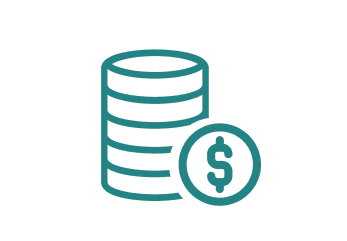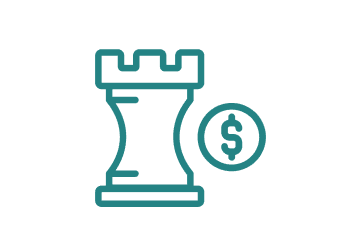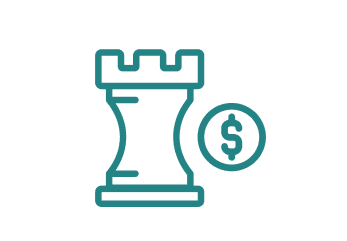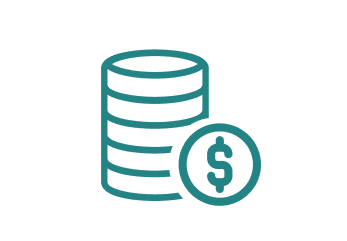A cash flow strategy is about more than keeping the lights on. Think about where you want your business to be in five or more years. Do you have the ability to take on unforeseen challenges or seize new opportunities? Or, is your business consistently preoccupied with paying the bills?
While small business cash flow management can often center on improving negative cash flow—which is expected during a period of growth or after a major investment—you need a plan that will set you up for sustainable growth. Consider these short-term and long-term strategies to boost cash flow, including an expert checklist from a seasoned CFO.

One-Time Actions & Funding Won’t Fix Underlying Cash Flow Issues
There are many immediate ways to free up cash, whether you delay new hires and major purchases or sell business assets that aren’t in use. You may seek loans or investor funding to keep your operations running and support growth. But your cash flow management strategy should not focus on one-time fixes or external resources every time. Your market strategy, internal processes and everyday financial management should be at the core of your cash flow strategy.
Explore the following immediate changes you can make to your accounts receivable and accounts payable functions, as well as long-term strategies for improving negative cash flow.
Tips for Managing Accounts Receivable
Small businesses can often adjust their accounts receivable processes easily as a way to increase cash inflow. Some adjustments you can make include:
- Reduce company invoice terms from net 30 to net 10.
- Require payment on receipt, particularly for consumables.
- Offer prepayment discounts when quotes are given.
- Train and incentivize the sales team to obtain down payments.
- Add a late penalty for debtor payments made after a deadline.
- Make subscription offers to encourage retainer contracts and even out cash flow.
- Increase the down payment amount required from 25% of the total price to 50% of the total price.
- Identify those customers who often make delayed payments and change their payment terms. Alternatively, cut off any future credit until overdue payments are received.
Tips for Managing Accounts Payable
Small businesses can also adjust the payments they make to make incremental improvements to their cash position. These accounts payable changes could involve the following:
- Negotiate payment plans to even out company cash flow.
- Request higher credit limits to support sales fluctuations.
- Consider buy versus lease options.
- Slow down your payments going out. Select invoices for payment based on their due date rather than paying each bill as soon as it arrives.
Long-Term Strategies to Correct Negative Cash Flow
Managing invoices and payments is a start, but it’s only a first step to a more sustainable small business cash flow management strategy. In order to improve cash flow in the long term, Paro fractional CFO Brooke S. recommends that small businesses assess their vulnerabilities and adopt a systematic approach to address liquidity risk. That includes analyzing cash flow forecasts and other business reports with an eye toward optimizing processes and minimizing costs.

When managing cash flow for small businesses, the following steps can make a more permanent impact:
Know Your Business
Understand your company goals and objectives first to drive focus and cadence for business forecasts. “Strategic vision is the anchor that guides you. Make sure projections and forecasts together support where the CEO is going,” Brooke advises.
When you know what makes your business profitable and where your competitive advantages lie, you can develop a sales strategy or overall market strategy that lends itself to better cash flow in the long term. Performing a business analysis of your pricing strategy or key drivers, for example, can help you identify how your business delivers value and where to focus resources to increase profitability.
Conduct Frequent Cash Flow Forecasts
How often you build cash flow forecasts depends on the rhythm of company transactions. Higher transaction volumes, large receivable or payable accounts and seasonal fluctuations demand that cash flows be monitored more closely. Weekly review, in this case, is expected.
Build a Cash Reserve
Set a monthly target within your company’s budget to build a cash reserve. You can even include these monthly targets in your forecasts or create a separate account for the reserve. This can provide additional flexibility to take advantage of new opportunities or prolong runway in more tumultuous times.
Improve Financial Reporting
Fix inaccurate data and eliminate irrelevant information to focus reports on what drives the business. For both new and existing reports, Brooke recommends asking four key questions when reviewing each financial or operational report:
- What is the purpose of the report?
- Can anyone reading it immediately understand the story behind it?
- Is it going to provide actionable information?
- Is the effort to create the report worth it?
Reassess Your KPIs
Identify what business metrics need to be prioritized or reprioritized to enhance performance and cash flow. Here are three KPIs that will likely be high on the priority list:
- Days Sales Outstanding (DSO) monitors accounts receivable collection.
- AR to Sales Ratio is the percentage of sales that are billed.
- Cash to Debt Coverage (CDC) measures the organization’s liquidity based on its ability to cover debt with current revenue.
Build Relationships With Your Suppliers Now
Good supplier relationships today keep a business top-of-mind during costly supply chain disruptions. “I have one business that I’m working with where they’ve [maintained good relationships], and because of that, now that we’re in a supply chain crunch, their needs are prioritized because they’ve maintained those relationships with their suppliers,” states Brooke.
Renegotiate Contracts
Seek additional flexibility and weigh the risks of being locked into suboptimal contracts. This can mean negotiating the terms of a loan with your lender or negotiating contracts for recurring subscriptions.
Hire the Right Talent Today
Spending on talent can greatly impact cash flow. Seek the skill sets you need through flexible talent models to save on costs and diversify your talent pool. By using flexible resources, you pay for the exact amount of work that you need and avoid the risk of paying for underutilized full-time talent.
Invest In Meaningful Technology Only
Don’t spend money on shiny new software features or technology that only serve to overcomplicate processes. Invest in technology that directly improves processes. This is not limited to technology that helps you automate or integrate siloes. This can also be technology that builds capacity for remote or hybrid workspaces.
Maintain Budget Discipline
Develop good habits today. Control spending in times of growth—not when finances are tight.
Who Can Help You With Your Cash Flow Management?
To build a small business cash flow management plan, different roles can help support at different levels. For example, an accountant can help you shore up your receivables or payables functions to manage your cash inflows and outflows in the short term. However, if you’re lacking visibility into your business or lack efficiency to operate towards your goals, then controller or fractional CFO expertise can help you determine a high-level strategy.
At Paro, we utilize our proprietary AI technology and in-depth industry expertise to match small businesses with the precise expert and cash flow management solution needed to grow their business. Our vetted fractional experts and financial forecasting consultants have more than 15 years of average experience working with businesses that face challenges just like yours.














